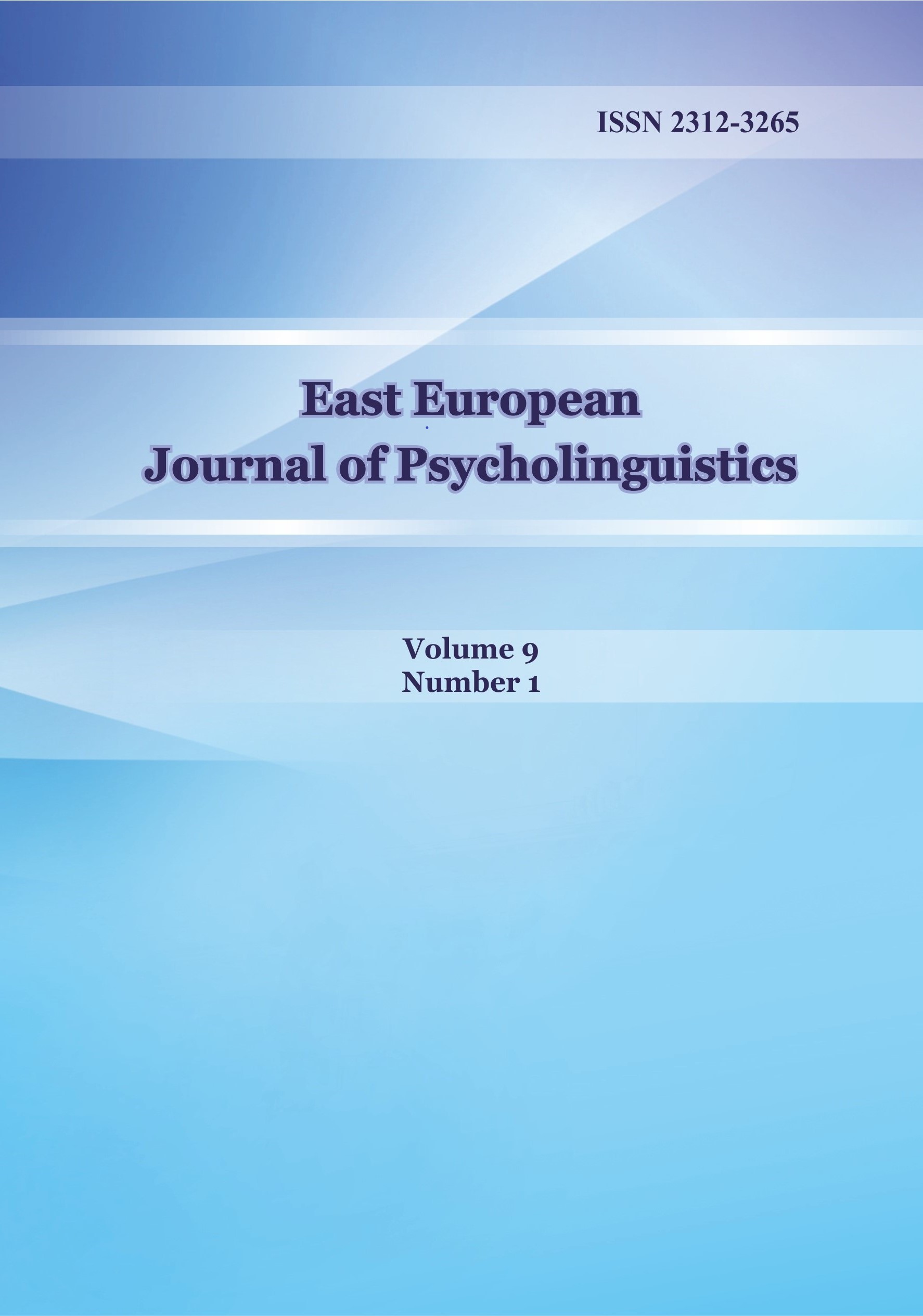Rural Bilingual Roma Children and Theory of Mind Competencies
DOI:
https://doi.org/10.29038/eejpl.2022.9.1.kyuKeywords:
Theory of Mind, Roma children, bilingualism, evidentiality, Yes/No questionsAbstract
Two age groups of Roma children (3;6-4;6 years old n = 20 and 4;7- 5;6 n = 20) from rural areas of Bulgaria were tested for understanding the classical Theory of Mind (TOM) task (False-belief) and the correlations with two language tests (Evidentiality and Yes/No Questions) were investigated. Coordinate with that the children were tested by means of the nonverbal Knox Cub Intelligent Test. The Theory of Mind tests and the language tests were conducted in both languages – L1 Romani and Bulgarian as their second language. The children attend kindergarten where they learn Bulgarian, but at home, they speak Romani as L1. All children were tested individually in a separate room by the researcher. A Roma woman member of the community and speaker of the dialect of the children tested them in Romani. All the results were analysed using ANOVA. The results frоm the study show that in the performance of both TOM tasks, the older children understand better the tasks and a high number of them have correct answers. The children performed equally well on the tests in both languages. The differences between Romani as L1 and Bulgarian as a second language are not significant. In the performance of the language tasks Evidentiality and Yes/No Questions there is a statistically significant correlation (p < .05000). There is also a correlation between L1 Romani and Bulgarian in performing the language tasks (p < .340526). However, there is no correlation between the language tasks and the TOM tasks. There are correlations between the variables Evidentiality Task Scores and Yes/No Question Task Scores (.4064); also between Evidentiality Task Scores and Knox’s Cube Nonverbal Intelligent Test Scores (.3969); and between the Yes/No Question Task Scores and Knox’s Cube Nonverbal Intelligent Test Scores (.5073). All correlations are only for the Romani language. The conclusion from the study is that the bilingual Roma children develop the Theory of Mind competencies around the age of 4;6 years old. Their language proficiency level in Romani and Bulgarian is basically equal, however when performing intelligence task the children are much better in their mother tongue. The children understand the Theory of Mind task in both languages in equal measure.
Downloads
References
Aksu-Koç, A. et al. (2005). The relation between mental verbs and theory of mind performance: Evidence from Turkish children. International Association for the Study of Child Language.
Alvarez, C. (2019). The Natural Laws of Children. Boulder: Shambhala.
Callaghan, T. et al. (2005). Synchrony in the onset of mental-state reasoning: Evidence from five cultures. Psychological Science, 16(5), 378-384. https://doi.org/10.1111/j.0956-7976.2005.01544.x
DeLuca, V. et al. (2019) Redefining bilingualism as a spectrum of experiences that differentially affects brain structure and function. Proceedings of the National Academy of Sciences, 116(15), 7565-7574.
de Villiers, J. (2007) The interface of language and theory of mind. Lingua, 117(11), 1858-1878.
de Villiers, J. & de Villiers, P. (2000). Linguistic determinism and the understanding of false beliefs. In P. Mitchell, K. Riggs, (Eds.). Children's Reasoning and the Mind. (pp. 189-226). Hove, UK: Psychology Press.
de Villiers, J. & Pyers, J. (2002). Complements to cognition: a longitudinal study of the relationship between complex syntax and false-belief-understanding. Cognitive Development, 17, 1037-1060.
Grosjean, F. (2010). Bilingual life and reality. Cambridge: Harvard University Press.
Kyuchukov, H. (2006). Early home literacy of Roma children in Bulgaria. Education et Sociétés Plurilingues, 20, 51-61.
Kyuchukov, H. (2021). The Roma Family’s Oral Culture and Folklore and Language Acquisition by Children. In H. Kyuchukov, S. Zahova, & I. Duminica, (Eds.). Romani history and culture. (pp. 227-235). Munich: Lincom.
Kyuchukov, H. (2007). Turkish and Roma children learning Bulgarian. Veliko Tarnovo: Faber.
Kyuchukov, H., & de Villiers, J. (2009). Theory of Mind and Evidentiality in Romani-Bulgarian Bilingual children. Psychology of Language and Communication, 13(2), 21-34.
Lilard, A. (2006). The socialization of theory of mind: Cultural and Social class differences in behavior explanation. In A. Antonietti, O.Liverta-Sempio & A. Marchetti, (Eds.). Theory of Mind and Language in Developmental Context. (pp. 65-76). NY: Springer.
Malone, S. (2007). Mother-tongue based multilingual education: Implications for education policy. Paper presented at the Seminar on Education Policy and the Right to Education. Kathmandu, Retrieved from https://www.academia.edu/6368207/MOTHER_TONGUE_BASED_MULTILINGUAL_EDUCATION_IMPLICATIONS_FOR_EDUCATION_POLICY_Defining_Mother_Tongue_based_Multilingual_Education_MT_Based_MLE
Navarro, E., DeLuca, V. Rossi, E. (2022). It takes a village: Using network science to identify the effect of individual differences in bilingual experience for Theory of Mind. Brain Sciences, 12, 487. https://doi.org/10.3390/brainsci12040487
Papafragou, A., & Li, P. (2001). Evidential morphology and theory of mind. In Proceedings from the 26th Annual Boston University Conference on Language Development. Cascadilla Press, Somerville, MA, pp. 510-520.
Shahaeian, A. Peterson, C. C., Slaughter, V., & Wellman, H. M. (2011). Culture and the sequence of steps in theory of mind development. Developmental Psychology, 47(5), 1239–1247. https://doi.org/10.1037/a0023899
Skutnabb-Kangas, T. (2015). Linguicism. Encyclopedia of Applied Linguistics. http://www.tove-skutnabb-kangas.org/dl/310-Skutnabb-Kangas-Tove-2015-Linguicism-Encyclopedia-of-Applied-Linguistics-Blackwell.pdf.
Skutnabb-Kangas, T. (2008). Humman Rights and Language Policy in Education. In S. May & N. Hornberger, (Eds.). Language policy and political issues in education, Vol. 1 of Encyclopedia of Language and Education, 2nd edition. (pp. 107-119). New York: Springer, Retrieved from http://www.tove-skutnabb-kangas.org/pdf/Human_rights_and_language_policy_in_education_Tove_Skutnabb_Kangas.pdf.
Smitherman, G. (1995). "Students' Right to Their Own Language": A Retrospective. The English Journal, 84(1), 21-27. Retrieved from https://www.academia.edu/45224507/Students_Right_to_Their_Own_Language_A_Retrospective.
Spotakova, M. (2011). Cognitive development and Theory of Mind in socially disadvantaged Roma children. In J. Stoyanova and H. Kyuchukov, (Eds.). Psychology and Linguistics. Sofia: Prosveta.
Surrain, S. and Luk, G. (2017). Describing bilinguals: A systematic review of labels and descriptions used in the literature between 2005–2015. Bilingualism: Language and Cognitions, 22, 401–415. https://doi.org/10.1017/S1366728917000682
Templer, W. (2016). Confronting linguicism: Rethinking multiculturalism and bilingual instruction in Bulgaria schools. In H. Kyuchukov (Ed.), New Trends in the Psychology of Language. (pp. 143-175). Munich: Lincom.
Downloads
Published
Issue
Section
License
Copyright (c) 2022 Hristo Kyuchukov

This work is licensed under a Creative Commons Attribution 4.0 International License.










 Creative Commons «Attribution» 4.0
Creative Commons «Attribution» 4.0